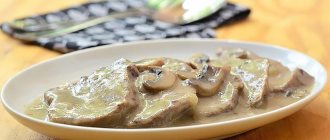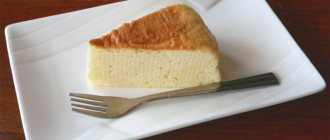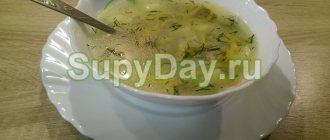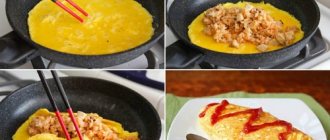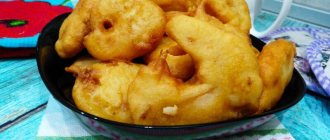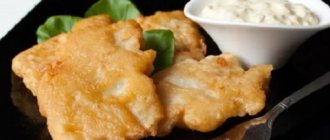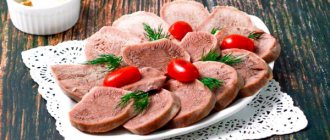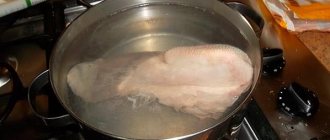1
Prepared by: Galina.budanova
05/12/2019 Cooking time: 4 hours 0 minutes
| Save | I cooked) | Estimate |
Today I want to share a recipe for Japanese Hokkaido Milk Bread. It turns out simply incredible, fluffy, soft as fluff. I recommend cooking it!
History of bread in Japan
Bread first arrived in Japan with Portuguese traders and missionaries in the mid-16th century. However, Christianity was banned in the early 17th century, and everyone who baked bread was Christian. But the name remains: the Japanese word for bread is pan, a local adaptation of the Portuguese word pão.
Although a recipe for the bread can be found in a book of Japanese sweets from 1718, there is no actual evidence that it was ever baked in the country itself. The first bread known to have been baked by a Japanese for the Japanese was made by Egawa Hidetatsu in 1842. In charge of the Tokugawa shogunate's coastal defenses around Tokyo Bay, he baked hard bread as food for soldiers and also built a reverberatory oven at Ijunokuni, Shizuoka Prefecture, which is now a UNESCO World Heritage Site.
Bread became more common along with Japan's rapid industrialization during the Meiji period (1868-1912). In 1874, Yasubei Kimura created anpan (あんパン), a bun filled with red beans called "an" or "anko". Since "anko" was widely used in Japanese sweets, its inclusion ensured the success of Kimura's bakery, Kimuraya Sohonten, which is still in operation today. Anpan was such a successful product that it was even introduced to Emperor Meiji, and a boom in sweet baked goods followed.
In 1890, bread was introduced as a staple food for the Japanese navy to combat vitamin B1 deficiency. After World War II, bread became a component of the school lunch system (kyusoku), which was created to combat post-war food shortages. The bread was baked using wheat and milk powder provided by the US occupation authorities.
At the same time, bread was made for sandwiches popular among US soldiers. Its shape was gradually changed to suit Japanese tastes, the bread became square and began to be called "shokupan" (食パン, literally "edible bread"). Shokupan can be found in every grocery store or supermarket to this day.
In 2011, everyone was surprised when Japanese households spent more on bread than on rice for the first time in their history. However, Japanese bread is quite expensive and the nation still only produces 1.2 million tons of bread compared to 8 million tons of rice in 2015, so rice is here to stay.
But bread is becoming a larger part of the national diet, particularly popular in the Kansai region. You can find at least one bakery or panya-san at any major train station across the country, and you will even find them hidden in the alleys of cities.
Cooking a dish step by step with photos
Step 1
To prepare this tender and airy bread, we need premium wheat flour, milk, cream (I have 10%), milk powder, chicken egg, granulated sugar, salt and yeast. You don’t have to use fast-acting yeast - just dry yeast (also 5 grams is a heaping teaspoon) or pressed yeast (you need 3 times more, that is, 15 grams) will do just fine. Such yeast is not immediately mixed with flour, but is pre-activated in a warm, sweetish liquid for 10-15 minutes. In our case, you can slightly heat half a glass of milk with a teaspoon of sugar and dissolve the yeast in it.
Step 2
Sift the wheat flour (preferably twice) into a large bowl. Due to this, the flour will not only loosen and be saturated with oxygen, but also possible debris will be removed.
Step 3
Add instant yeast, granulated sugar, milk powder and salt to the flour. Mix everything thoroughly with a fork or whisk.
Step 4
Now you need to combine the bulk mixture with the liquid ingredients for the dough. To do this, make a well in the flour and pour warm (slightly warmer than the human body) milk and cream into it. We break a chicken egg there. It is at this stage that yeast milk is added if you are using dry or pressed yeast.
Step 5
Now knead the dough for at least 10, and preferably 15-20 minutes. It should become completely homogeneous, smooth, tender and very soft. Cover the bowl with cling film or cover with a towel and leave to ferment in a warm place for 1.5 hours. After 40 minutes (of the total time), gently knead the dough to release carbon dioxide from it, round it and return to heat.
Step 6
This is what the dough looks like after 1.5 hours of fermentation - it has grown very well and has increased in volume exactly three times. But I want to say that an hour and a half is not at all necessary, because the temperature in the room is different for everyone, and so is the strength of the yeast, so the main thing is that the dough rises well. And this may require more time (and for some less).
Step 7
Now divide the dough into 4 equal parts. Roll each into a ball and place on a board sprinkled with flour. Cover with something to prevent it from becoming airy and crusty, and leave to rest for 20 minutes.
Step 8
During this time, our buns will swell (that is, they will begin to ferment again) - they are ready for further work. It's time to move on to shaping the milk bread.
Step 9
Sprinkle the work surface a little with wheat flour (the mixture is not included in the above ingredients) and roll out one log long with a rolling pin. It turns out this long oval (ideally a rectangle) across the width of the form. The dough is very tender and pliable, perfectly listenable.
Step 10
Roll the layer into a tight roll, folding the edges of the dough in parallel. After each turn, be sure to press the roller to the layer so that later there are no voids (that is, large air bubbles) in the finished bread.
Step 11
This is the kind of dough roll you should get. In total we make 4 rolls according to the number of pieces of dough.
Step 12
Now we place the blanks in a baking dish, which we grease with a small amount of vegetable oil (butter is better - it lays out more evenly) oil. I didn’t list it in the ingredients either—literally a tablespoon is enough. Cover the workpiece with a towel or cling film and leave for 1-1.5 hours. The time again depends on the temperature in the kitchen and the activity of the yeast. The main thing is that the dough rises well. At this time, heat the oven (175 degrees).
Step 13
When the workpiece has doubled in size, you can put the future bread in a hot oven.
Step 14
But before that, brush the dough with milk for a golden brown crust. By the way, you can use egg yolk or a mixture of yolk and milk for the same purpose.
Step 15
Bake Japanese Hokkaido milk bread at 175 degrees for about 40 minutes. As you can see, the baked goods have risen very well and are perfectly browned. And what a scent!
Step 16
Let the finished bread stand in the pan for a couple of minutes, then take it out and cool on a wire rack.
Once the milk bread has cooled completely, it is ready to cut. Be sure to try this delicate milk cloud with an airy, aromatic crumb and the finest golden brown crust.
Melon Pan
Don't let the name fool you: melon pan (メロンパン) is simply coated in a thick cookie dough and then baked, giving the bun a crispy, sweet exterior. It doesn't have any melon flavor, although some manufacturers now add melon flavorings or dye it green.
There are two theories to explain the origin of the name: the first is that the cross pattern on the top of the bun is similar to the rind of a cantaloupe; the other is that it used to be called "merengue pan", and the name gradually turned into "melon pan" (melon pan). Theories about the origin of this bread also vary, with some dating as far back as 1910.
Katsu-sando
Katsu-sando (cutlet sandwich) is simply a breaded pork cutlet sandwiched between pieces of bread, usually served with mustard and cut into two or three pieces. You will find them in convenience stores, train stations and bakeries.
Katsu-sando was first baked in 1935 in Ueno, where it was prepared as a snack for geishas working in the red light district at the time.
Yakisoba pan
Yakisoba Pan – (焼きそばパン) is a hot dog with fried yakisoba noodles. It was created when a store selling yakisoba and bread in 1950 advised customers to combine the two products together for a better sake experience.
These are just the main types of Japanese bread that you can enjoy when you come to study in Japan or buy a tour to this country. Japanese bakeries are growing, and while most shops focus on basic white bread, puff pastries and muffins, it's easy to find specialty shops selling excellent German-style brown and walnut breads. Bagels are more common than ever, although corn bread remains a curiosity.
So there's still room for improvement, but with so much variety on the shelves - from cheese bread and chocolate croissants to sausage bread and classic enpan - you're sure to find something delicious that's sure to please!
Ingredients
For 2 loaves weighing approximately 500-600g:
- 15-20 g fresh yeast;
- 80 g sugar;
- 250 ml warm milk;
- 150 ml cream 30%;
- 1 medium egg;
- 30 g milk powder;
- ¼ teaspoon salt;
- 600-620 g flour + 50 g for adding;
- 1 tablespoon butter or sunflower oil for greasing the mold.
How to bake:
First, we make the dough: crumble the yeast into a bowl, grind with 2 tablespoons of sugar until liquid, pour in warm milk and stir.
Then sift a little more than a glass of flour (150 g, that is, a quarter of the total amount) - approximately, so that after mixing you get a thin dough. Place the dough in a warm place for 20 minutes.
When the dough rises into an airy “cap,” you can begin kneading the dough.
Add room temperature cream and the rest of the sugar to the dough and mix.
Then add the egg, also at room temperature - yeast dough loves warmth! It can be “scared” of cold ingredients, just like hot ones. But if you add everything warm and handle the dough carefully, it will reciprocate, and you will get the most fluffy and delicious baked goods!
After mixing the dough with the egg, we begin to gradually add flour, sifting it through a sieve or colander. We also sift the powdered milk so that there are no lumps and the dough is enriched with oxygen. And don’t forget to add salt! Even sweet baked goods taste much better with a pinch of salt.
You may need more or less flour, depending on its properties. Add about 600 g or a little more to the dough, and add the rest as needed, kneading the dough on the table. You don’t need to sprinkle too much flour so that the dough turns out fluffy rather than tough. It’s better to knead well, for about 15 or even 20 minutes. Then the dough becomes soft, does not stick to your hands, and is pleasant to work with. itemprop="image"
After greasing a bowl with oil, place the dough in it, cover with a towel and place in a warm place for 1.5 hours or until it doubles in volume.
Then gently knead the dough and divide it into several parts. In the original, where the recipe is written in hieroglyphs - into 4. I divided it into 7 parts, because 4 large rolls would not fit into the mold.
Having rolled the dough pieces into balls, let them rise for about 15 minutes on a table sprinkled with flour.
Then roll out each lump of dough one by one into a small rectangle.
We wrap the edges of the rectangle inward, and roll the rectangle itself into a tight roll.
Having covered the form with parchment, which has been greased, place the rolls in it next to each other.
And let the bread rise in a warm place for about 45 minutes to an hour until the bread rises and doubles in size.
When the bread is ready, carefully brush the top with milk.
Preheat the oven to 180C and bake the bread for 30-40 minutes, until the skewer is dry and the top is brightly browned.
Remove the finished bread from the pan after 10 minutes and then cool on a wire rack.
Break off pieces of a fluffy, delicious bun and enjoy the taste of Hokkaido - bread originally from the distant Pacific islands!
And here are the buns from those rolls that didn’t fit in the pan.
- 5
- 4
- 3
- 2
- 1
(13 votes, average: 4.5 out of 5)
Post tags: cream,

